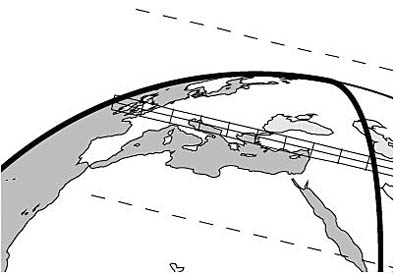An asteroidal occultation prediction for 2014 March 7
2013 November 29
 On 2014 March 7 at 03:08UT, asteroid (9) Metis is predicted to occult a magnitude 7.9 star in Libra (HIP 78193). The maximum duration is around 25sec. Observers in the UK and Europe should see an occultation or a very close appulse depending on their location. Tick marks on the track are one minute intervals starting on the left at 03:07UT. The shadow track is approx. 372km wide.
On 2014 March 7 at 03:08UT, asteroid (9) Metis is predicted to occult a magnitude 7.9 star in Libra (HIP 78193). The maximum duration is around 25sec. Observers in the UK and Europe should see an occultation or a very close appulse depending on their location. Tick marks on the track are one minute intervals starting on the left at 03:07UT. The shadow track is approx. 372km wide.
An updated prediction is likely a few weeks prior to the event, providing a more accurate shadow path. The prediction currently has a 0.15 path uncertainty. The dotted lines represent the maximum error in the prediction calculated a year in advance by E. Goffin.
This prediction involves a reasonably bright star 9° from Saturn with several brighter field stars, making this an excellent opportunity to find and record a rare and dramatic event. During the occultation the star will disappear behind the 11th magnitude asteroid, which itself should be visible in medium sized instruments. A drop in brightness of 3.2 magnitudes should make this a very noticeable event. Observers are invited to time the disappearance and duration of the occultation with 0.5 sec accuracy (or better where possible) using a clock synchronised to UT, and to report the result to the Asteroids & Remote Planets Section.
 Several observations of the event would translate to an accurate outline of the minor planet (see left). A description of how to observe and report asteroidal occultations can be found in the 2014 BAA Handbook, page 47.
Several observations of the event would translate to an accurate outline of the minor planet (see left). A description of how to observe and report asteroidal occultations can be found in the 2014 BAA Handbook, page 47.
| The British Astronomical Association supports amateur astronomers around the UK and the rest of the world. Find out more about the BAA or join us. |
